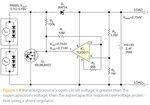aspirecole
Member level 1

- Joined
- Oct 1, 2013
- Messages
- 32
- Helped
- 0
- Reputation
- 0
- Reaction score
- 0
- Trophy points
- 6
- Activity points
- 198
i want to build an electric bike using battery and supercapacitor.. the supercap is used during the the high peak demand which is during uphill ride..
what circuit should i use to discharge the energy from the supercap to charge the battery??
what circuit should i use to discharge the energy from the supercap to charge the battery??




